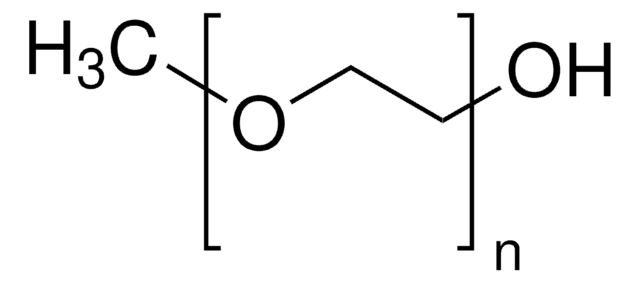Alle Fotos(4)
Wichtige Dokumente
373001
Poly(ethylenglykol)
average Mn 4,600, hydroxyl
Synonym(e):
PEG
Anmeldenzur Ansicht organisationsspezifischer und vertraglich vereinbarter Preise
Alle Fotos(4)
About This Item
Lineare Formel:
H(OCH2CH2)nOH
CAS-Nummer:
MDL-Nummer:
UNSPSC-Code:
12352104
PubChem Substanz-ID:
NACRES:
NA.23
Empfohlene Produkte
Produktbezeichnung
Poly(ethylenglykol), average Mn 4,600
Form
flakes
Mol-Gew.
average Mn 4,400-4,800
average Mn 4,600
Viskosität
180 cSt(210 °F)
mp (Schmelzpunkt)
57-61 °C (lit.)
Ω-Ende
hydroxyl
α-Ende
hydroxyl
SMILES String
C(CO)O
InChI
1S/C2H6O2/c3-1-2-4/h3-4H,1-2H2
InChIKey
LYCAIKOWRPUZTN-UHFFFAOYSA-N
Suchen Sie nach ähnlichen Produkten? Aufrufen Leitfaden zum Produktvergleich
Verwandte Kategorien
Allgemeine Beschreibung
Poly(ethylene glycol) (PEG) is a biocompatible water soluble poly(ether) with low toxicity. It is majorly used as a biopolymer for the surface modification of biomaterials. Its properties include hydrophilicity and non-immunogenicity.
Anwendung
PEG can be used in the formation of polymeric hydrogels for the formation of biomedical applications.
Lagerklassenschlüssel
11 - Combustible Solids
WGK
WGK 1
Flammpunkt (°F)
Not applicable
Flammpunkt (°C)
Not applicable
Persönliche Schutzausrüstung
Eyeshields, Gloves, type N95 (US)
Hier finden Sie alle aktuellen Versionen:
Besitzen Sie dieses Produkt bereits?
In der Dokumentenbibliothek finden Sie die Dokumentation zu den Produkten, die Sie kürzlich erworben haben.
Kunden haben sich ebenfalls angesehen
Nano-magnetic particles used in biomedicine: Core and coating materials
Karimi Z, et al.
Materials Science and Engineering Technology, 33(5), 2465-2475 (2013)
Bacterial adhesion is affected by the thickness and stiffness of poly (ethylene glycol) hydrogels
Kolewe KW, et al.
ACS Applied Materials & Interfaces, 10(3), 2275-2281 (2018)
Biomedical hydrogels
Burdick JA, et al.
Biomaterials, Artificial Organs and Tissue Engineering, 33(5), 107-115 (2005)
Morphology of Photopolymerized End-linked Poly(ethylene glycol) Hydrogels by Small Angle X-ray Scattering
Waters DJ, et al.
Macromolecules, 43(16), 6861-6861 (2010)
Idalis Villanueva et al.
Acta biomaterialia, 5(8), 2832-2846 (2009-06-11)
The pericellular matrix (PCM) surrounding chondrocytes is thought to play an important role in transmitting biochemical and biomechanical signals to the cells, which regulates many cellular functions including tissue homeostasis. To better understand chondrocytes interactions with their PCM, three-dimensional poly(ethylene
Unser Team von Wissenschaftlern verfügt über Erfahrung in allen Forschungsbereichen einschließlich Life Science, Materialwissenschaften, chemischer Synthese, Chromatographie, Analytik und vielen mehr..
Setzen Sie sich mit dem technischen Dienst in Verbindung.


